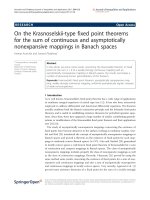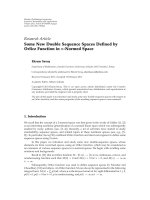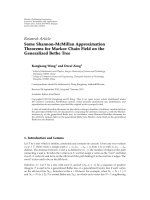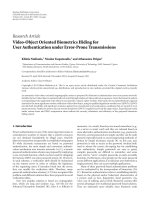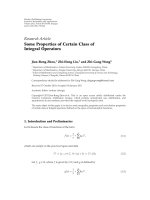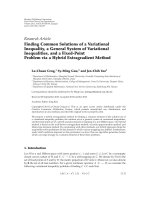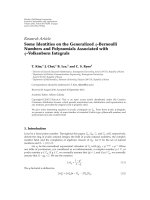Báo cáo hóa học: " Research Article Some Common Fixed Point Theorems for Weakly Compatible Mappings in Metric Space" docx
Bạn đang xem bản rút gọn của tài liệu. Xem và tải ngay bản đầy đủ của tài liệu tại đây (477.14 KB, 8 trang )
Hindawi Publishing Corporation
Fixed Point Theory and Applications
Volume 2009, Article ID 804734, 8 pages
doi:10.1155/2009/804734
Research Article
Some Common Fixed Point Theorems for Weakly
Compatible Mappings in Metric Spaces
M. A. Ahmed
Department of Mathematics, Faculty of Science, Assiut University, Assiut 71516, Egypt
Correspondence should be addressed to M. A. Ahmed,
Received 23 October 2008; Accepted 18 January 2009
Recommended by William A. Kirk
We establish a common fixed point theorem for weakly compatible mappings generalizing a result
of Khan and Kubiaczyk 1988. Also, an example is given to support our generalization. We also
prove common fixed point theorems for weakly compatible mappings in metric and compact
metric spaces.
Copyright q 2009 M. A. Ahmed. This is an open access article distributed under the Creative
Commons Attribution License, which permits unrestricted use, distribution, and reproduction in
any medium, provided the original work is properly cited.
1. Introduction
In the last years, fixed point theorems have been applied to show the existence and
uniqueness of the solutions of differential equations, integral equations and many other
branches mathematics see, e.g., 1–3. Some common fixed point theorems for weakly
commuting, compatible, δ-compatible and weakly compatible mappings under different
contractive conditions in metric spaces have appeared in 4–15. Throughout this paper,
X, d is a metric space.
Following 9, 16, we define,
2
X
A ⊂ X : A is nonempty
,
BX
A ∈ 2
X
: A is bounded
.
1.1
For all A, B ∈ BX, we define
δA, Bsup
da, b : a ∈ A, b ∈ B
,
DA, Binf
da, b : a ∈ A, b ∈ B
,
HA, Binf
r>0:A
r
⊃ B, B
r
⊃ A
,
1.2
2 Fixed Point Theory and Applications
where A
r
{x ∈ X : dx, a <r, for some a ∈ A} and B
r
{y ∈ X : dy, b <r, for some
b ∈ B}.
If A {a} for some a ∈ A, we denote δa, B, Da, B and Ha, B for δA, B, DA, B
and HA, B, respectively. Also, if B {b}, then one can deduce that δA, BDA, B
HA, Bda, b.
It follows immediately from the definition of δA, B that, for every A, B, C ∈ BX,
δA, BδB, A
≥ 0,δA, B ≤ δA, CδC, B,δA, B0,
iff A B {a},δA, Adiam A.
1.3
We need the following definitions and lemmas.
Definition 1.1 see 16. A sequence A
n
of nonempty subsets of X is said to be convergent to
A ⊆ X if:
i each point a in A is the limit of a convergent sequence a
n
, where a
n
is in A
n
for
n ∈{0}∪N N: the set of all positive integers,
ii for arbitrary >0, there exists an integer m such that A
n
⊆ A
for n>m, where A
denotes the set of all points x in X for which there exists a point a in A, depending
on x, such that dx, a <.
A is then said to be the limit of the sequence A
n
.
Definition 1.2 see 9. A set-valued function F : X → 2
X
is said to be continuous if for any
sequence x
n
in X with lim
n →∞
x
n
x, it yields lim
n →∞
HFx
n
,Fx0.
Lemma 1.3 see 16. If A
n
and B
n
are sequences in BX converging to A and B in BX,
respectively, then the sequence δA
n
,B
n
converges to δA, B.
Lemma 1.4 see 16. Let A
n
be a sequence in BX and let y be a point in X such that
δA
n
,y → 0. Then the sequence A
n
converges to the set {y} in BX.
Lemma 1.5 see 9. For any A, B, C, D ∈ BX, it yields that δA, B ≤ HA, CδC, D
HD, B.
Lemma 1.6 see 17. Let Ψ : 0, ∞ → 0, ∞ be a right continuous function such that Ψt <t
for every t>0. Then, lim
n →∞
Ψ
n
t0 for every t>0,whereΨ
n
denotes the n-times repeated
composition of Ψ with itself.
Definition 1.7 see 15. The mappings I : X → X and F : X → BX are weakly commuting
on X if IFx ∈ BX and δFIx,IFx ≤ max{δIx,Fx, diam IFx} for all x ∈ X.
Definition 1.8 see 13. The mappings I : X → X and F : X → BX are said to be δ-
compatible if lim
n →∞
δFIx
n
,IFx
n
0 whenever x
n
is a sequence in X such that IFx
n
∈
BX, Fx
n
→{t} and Ix
n
→ t for some t ∈ X.
Definition 1.9 see 13. The mappings I : X → X and F : X → BX are weakly compatible
if they commute at coincidence points, that is, for each point u ∈ X such that Fu {Iu}, then
FIu IFu note that the equation Fu {Iu} implies that Fu is a singleton.
Fixed Point Theory and Applications 3
If F is a single-valued mapping, then Definition 1.7 resp., Definitions 1.8 and 1.9
reduces to the concept of weak commutativity resp., compatibility and weak compatibility
for single-valued mappings due to Sessa 18resp., Jungck 11, 12.
It can be seen that
weakly commuting ⇒ δ-compatible and δ-compatible ⇒ weakly compatible, 1.4
but the converse of these implications may not be true see, 13, 15.
Throughtout this paper, we assume that Φ is the set of all functions φ : 0, ∞
5
→
0, ∞ satisfying the following conditions:
i φ is upper semi-continuous continuous at a point 0 from the right, and non-
decreasing in each coodinate variable,
ii For each t>0, Ψtmax{φt, t, t, t, t,φt, t, t, 2t, 0,φt, t, t, 0, 2t} <t.
Theorem 1.10 see 19. Let F, G be mappings of a complete metric space X, d into BX and
I be a mapping of X into itself such that I, F and G are continuous, FX ⊆ JX, GX ⊆ IX,
IF FI, IG GI and for all
x, y ∈ X,
δFx,Gy ≤ φdIx,Iy,δIx,Fx,δIy,Gy,DIx,Gy,DIy,Fx, 1.5
where φ satisfies (i) and φt, t, t, at, bt <tfor each t>0, and a ≥ 0, b ≥ 0 with a b ≤ 2.ThenI, F
and G have a unique common fixed point u such that u Iu ∈ Fu ∩ Gu.
In the present paper, we are concerned with the following:
1 replacing the commutativity of the mappings in Theorem 1.10 by the weak
compatibility of a pair of mappings to obtain a common fixed point theorem metric
spaces without the continuity assumption of the mappings,
2 giving an example to support our generalization of Theorem 1.10,
3 establishing another common fixed point theorem for two families of set-valued
mappings and two single-valued mappings,
4 proving a common fixed point theorem for weakly compatible mappings under a
strict contractive condition on compact metric spaces.
2. Main Results
In this section, we establish a common fixed point theorem in metric spaces generalizing
Theorems 1.10. Also, an example is introduced to support our generalization. We prove a
common fixed point theorem for two families of set-valued mappings and two single-valued
mappings. Finally, we establish a common fixed point theorem under a strict contractive
condition on compact metric spaces.
4 Fixed Point Theory and Applications
First we state and prove the following.
Theorem 2.1. Let I, J be two sefmaps of a metric space X, d and let F, G : X → BX be two
set-valued mappings with
∪ FX ⊆ JX, ∪ GX ⊆ IX. 2.1
Suppose that one of IX and JX is complete and the pairs {F, I } and {G, J} are weakly compatible.
If there exists a function φ ∈ Φ such that for all x, y ∈ X,
δFx,Gy ≤ φdIx,Jy,δIx,Fx,δJy,Gy,DIx,Gy,DJy,Fx,
2.2
then there is a point p ∈ X such that {p} {Ip} {Jp} Fp Gp.
Proof. Let x
0
be an arbitrary point in X.By2.1, we choose a point x
1
in X such that
Jx
1
∈ Fx
0
Z
0
and for this point x
1
there exists a point x
2
in X such that Ix
2
∈ Gx
1
Z
1
.
Continuing this manner we can define a sequence x
n
as follows:
Jx
2n1
∈ Fx
2n
Z
2n
,Ix
2n2
∈ Gx
2n1
Z
2n1
, 2.3
for n ∈{0}∪N. For simplicity, we put V
n
δZ
n
,Z
n1
for n ∈{0}∪N.By2.2 and 2.3,
we have that
V
2n
δ
Z
2n
,Z
2n1
δ
Fx
2n
,Gx
2n1
≤ φ
d
Ix
2n
,Jx
2n1
,δ
Ix
2n
,Fx
2n
,δ
Jx
2n1
,Gx
2n1
,D
Ix
2n
,Gx
2n1
,D
Jx
2n1
,Fx
2n
≤ φ
δ
Z
2n−1
,Z
2n
,δ
Z
2n−1
,Z
2n
,δ
Z
2n
,Z
2n1
,δ
Z
2n−1
,Z
2n
δ
Z
2n
,Z
2n1
, 0
φ
V
2n−1
,V
2n−1
,V
2n
,V
2n−1
V
2n
, 0.
2.4
If V
2n
>V
2n−1
, then
V
2n
≤ φV
2n
,V
2n
,V
2n
, 2V
2n
, 0 ≤ ΨV
2n
<V
2n
. 2.5
This contradiction demands that
V
2n
≤ φ
V
2n−1
,V
2n−1
,V
2n−1
, 2V
2n−1
, 0
≤ Ψ
V
2n−1
. 2.6
Similarly, one can deduce that
V
2n1
≤ φ
V
2n
,V
2n
,V
2n
, 0, 2V
2n
≤ Ψ
V
2n
. 2.7
So, for each n ∈{0}∪N,weobtainthat
V
n1
≤ Ψ
V
n
≤ Ψ
2
V
n−1
≤··· ≤Ψ
n
V
1
, 2.8
Fixed Point Theory and Applications 5
where V
1
δZ
1
,Z
2
δFx
2
,Gx
1
≤ φV
0
,V
0
,V
0
, 0, 2V
0
.By2.8 and Lemma 1.6,weobtain
that lim
n →∞
V
n
lim
n →∞
δZ
n
,Z
n1
0. Since
δ
Z
n
,Z
m
≤ δ
Z
n
,Z
n1
δ
Z
n1
,Z
n2
··· δ
Z
m−1
,Z
m
, 2.9
then lim
n,m →∞
δZ
n
,Z
m
0. Therefore, Z
n
is a Cauchy sequence.
Let z
n
be an arbitrary point in Z
n
for n ∈{0}∪N. Then lim
n,m →∞
dz
n
,z
m
≤
lim
n,m →∞
δZ
n
,Z
m
0andz
n
is a Cauchy sequence. We assume without loss of generality
that JX is complete. Let x
n
be the sequence defined by 2.3.ButJx
2n1
∈ Fx
2n
Z
2n
for
all n ∈{0}∪N. Hence, we find that
d
Jx
2m−1
,Jx
2n1
≤ δ
Z
2m−2
,Z
2n
≤ V
2m−2
δ
Z
2m−1
,Z
2n
−→ 0, 2.10
as m, n →∞.So,Jx
2n1
is a Cauchy sequence. Hence, Jx
2n1
→ p Jv ∈ JX for some
v ∈ X.ButIx
2n
∈ Gx
2n−1
Z
2n−1
by 2.3,sothatdIx
2n
,Jx
2n1
≤ δZ
2n−1
,Z
2n
V
2n−1
→ 0.
Consequently, Ix
2n
→ p. Moreover, we have, for n ∈{0}∪N,thatδFx
2n
,p ≤ δFx
2n
,Ix
2n
dIx
2n
,p ≤ V
2n−1
dIx
2n
,p. Therefore, δFx
2n
,p → 0. So, we have by Lemma 1.4 that
Fx
2n
→{p}. In like manner it follows that δGx
2n1
,p → 0andGx
2n1
→{p}.
Since, for n ∈{0}∪N,
δ
Fx
2n
,Gv
≤ φ
d
Ix
2n
,Jv
,δ
Ix
2n
,Fx
2n
,δ
Jv,Gv
,D
Ix
2n
,Gv
,D
Jv,Fx
2n
≤ φ
d
Ix
2n
,Jv
,δ
Ix
2n
,Fx
2n
,δ
Jv,Gv
,δ
Ix
2n
,Gv
,δ
Jv,Fx
2n
,
2.11
and δIx
2n
,Gv → δp, Gv as n →∞,wegetfromLemma 1.3 that
δp, Gv ≤ φ
0, 0,δp, Gv,δp, Gv, 0
≤ Ψ
δp, Gv
<δp, Gv. 2.12
This is absurd. So, {p} Gv {Jv}.But∪ GX ⊆ IX,so∃u ∈ X such that {Iu} Gv
{Jv}.IfFu
/
Gv, δFu, Gv
/
0, then we have
δ
Fu,pδFu,Gv
≤ φ
dIu,Jv,δIu,Fu,δJv,Gv,DIu,Gv,DJv,Fu
≤ φ
dIu,Jv,δIu,Fu,δJv,Gv,δIu,Gv,δJv,Fu
φ
0,δFu,p, 0, 0,δFu,p
≤ Ψ
δFu,p
<δFu,p.
2.13
We must conclude that{p} Fu Gv {Iu} {
Jv}.
6 Fixed Point Theory and Applications
Since Fu {Iu} and the pair {F, I} is weakly compatible, so Fp FIu IFu {Ip}.
Using the inequality 2.2, we have
δFp,p ≤ δFp,Gv
≤ φ
dIp,Jv,δIp,Fp,δJv,Gv,DIp,Gv,D
Jv,Fp
≤ φ
δFp,p, 0, 0,δFp,p,δFp,p
≤ Ψ
δFp,p
<δFp,p.
2.14
This contradiction demands that {p}
Fp {Ip}. Similarly, if the pair {G, J} is weakly
compatible, one can deduce that {p} Gp {Jp}. Therefore, we get that {p} Fp Gp
{Ip} {Jp}.
The proof, assuming the completeness of IX, is similar to the above.
To see that p is unique, suppose that {q} Fq Gq {Iq} {Jq}.Ifp
/
q, then
dp, qδFp,Gq ≤ φ
dp, q, 0, 0,dp, q,dp, q
≤ Ψ
dp, q
<dp, q, 2.15
which is inadmissible. So, p q.
Now, we give an example to show the greater generality of Theorem 2.1 over
Theorem 1.10.
Example 2.2. Let X 0, 1 endowed with the Euclidean metric d. Assume that
φt
1
,t
2
,t
3
,t
4
,t
5
t
1
/3 for every t
1
,t
2
,t
3
,t
4
,t
5
∈ 0, ∞. Define F, G : X → BX and
I,J : X → Xas follows:
Fx
1
2
if x ∈ X, Gx
1
2
if x ∈
0,
1
2
,Gx
3
8
,
1
2
if x ∈
1
2
, 1
,
Ix
1
2
if x ∈
0,
1
2
,Ix
x 1
4
if x ∈
1
2
, 1
,Jx 1 − x if x ∈
0,
1
2
,
Jx 0ifx ∈
1
2
, 1
.
2.16
We have that ∪ FX{1/2} {J1/2}⊆JX and ∪ GX3/8, 1/2IX.
Moreover, δFx,Gy0ify ∈ 0, 1/2.Ify ∈ 1/2, 1, then δFx,Gy ≤ 1/8anddIx,Jy ≥
3/8. So, we obtain that
δFx,Gy ≤
1
3
dIx,Jy
1
3
φ
dIx,Jy,δIx,Fx,δJy,Gy,DIx,Gy,DJy,Fx
,
2.17
for all x, y ∈ X. It is clear that X is a complete metric space. Since JX1/2, 1 ∪
{0} is a closed subset of X,soJX is complete. We note that {F, I} is a δ-compatible
Fixed Point Theory and Applications 7
pair and therefore a weakly compatible pair. Also, G1/2{J1/2} and GJ1/2
JG1/2{1/2},thatis,G and J are weakly compatible. On the other hand, if x
n
1/2 − 2
−n
,sothatδGJx
n
,JGx
n
→ 1/8
/
0 even though Gx
n
, {Jx
n
}→{1/2},thatis,
{G, J} is not a δ-compatible pair. We know that 1/2 is the unique common fixed point
of I, J,F and G. Hence the hypotheses of Theorem 2.1 are satisfied. Theorem 1.10 is not
applicable because GJx
/
JGx for all x ∈ X, and the maps I, J and G are not continuous at
x 1/2.
In Theorem 2.1, if the mappings F and G are replaced by F
α
and G
α
, α ∈ Λ where Λ is
an index set, we obtain the following.
Theorem 2.3. Let X, d be a metric space, and let I,J be selfmaps of X, and for α ∈ Λ, F
α
,G
α
: X →
BX be set-valued mappings with ∪∪
α∈Λ
F
α
X ⊆ JX and ∪∪
α∈Λ
G
α
X ⊆ IX. Suppose that
one of IX and JX is complete and for α ∈ Λ the pairs {F
α
,I} and {G
α
,J} are weakly compatible.
If there exists a function φ ∈ Φ such that, for all x, y ∈ X,
δ
F
α
x, G
α
y
≤ φ
dIx,Jy,δ
Ix,F
α
x
,δ
Jy,G
α
y
,D
Ix,G
α
y
,D
Jy,F
α
x
, 2.18
then there is a point p ∈ X such that {p} {Ip} {Jp} F
α
p G
α
p for each α ∈ Λ.
Proof. Using Theorem 2.1, we obtain for any α ∈ Λ, there is a unique point z
α
∈ X such that
Iz
α
Jz
α
z
α
and F
α
z
α
G
α
z
α
{z
α
}. For all α, β ∈ Λ,
d
z
α
,z
β
≤ δ
F
α
z
α
,G
β
z
β
≤ φ
d
Iz
α
,Jz
β
,δ
Iz
α
,F
α
z
α
,δ
Jz
β
,G
β
z
β
,D
Iz
α
,G
β
z
β
,D
Jz
β
,F
α
z
α
≤ φ
d
z
α
,z
β
, 0, 0,d
z
α
,z
β
,d
z
β
,z
α
≤ Ψ
d
z
α
,z
β
<d
z
α
,z
β
.
2.19
This yields that z
α
z
β
.
Inspired by the work of Chang 9, we state the following theorem on compact metric
spaces.
Theorem 2.4. Let X, d be a compact metric space, I, J selfmaps of X, F, G : X → BX set-valued
functions with ∪ FX ⊆ JX and ∪ GX ⊆ IX. Suppose that the pairs {F, I}, {G, J} are weakly
compatible and the functions F, I are continuous. If there exists a function φ ∈ Φ, and for all x, y ∈ X,
the following inequality:
δFx,Gy <φ
dIx,Jy,δIx,Fx,δJy,Gy,DIx,Gy,DJy,Fx
, 2.20
holds whenever the right-hand side of 2.20 is positive, then there is a unique point u in
X such that
Fu Gu {u} {Iu} {Ju}.
8 Fixed Point Theory and Applications
Acknowledgment
The author wishes to thank the refrees for their comments which improved the original
manuscript.
References
1 H. K. Pathak and B. Fisher, “Common fixed point theorems with applications in dynamic
programming,” Glasnik Matemati
ˇ
cki, vol. 31, no. 51, pp. 321–328, 1996.
2 H. K. Pathak, M. S. Khan, and R. Tiwari, “A common fixed point theorem and its application to
nonlinear integral equations,” Computers & Mathematics with Applications, vol. 53, no. 6, pp. 961–971,
2007.
3 H. K. Pathak, S. N. Mishra, and A. K. Kalinde, “Common fixed point theorems with applications to
nonlinear integral equations,” Demonstratio Mathematica, vol. 32, no. 3, pp. 547–564, 1999.
4 M. A. Ahmed, “Common fixed point theorems for weakly compatible mappings,” The Rocky Mountain
Journal of Mathematics, vol. 33, no. 4, pp. 1189–1203, 2003.
5 M. A. Ahmed, “Common fixed points for four mappings under a contractive condition of Kiventidis
type,” Proceedings of the Mathematical and Physical Society of Egypt, no. 83, pp. 83–93, 2005.
6 M. A. Ahmed and B. E. Rhoades, “Some common fixed point theorems for compatible mappings,”
Indian Journal of Pure and Applied Mathematics, vol. 32, no. 8, pp. 1247–1254, 2001.
7 A. Banerjee and T. B. Singh, “A fixed point theorem for set-valued mappings,” Applied Mathematics
and Mechanics, vol. 22, no. 12, pp. 1397–1403, 2001.
8 A. Banerjee and B. S. Thakur, “A note on a theorem of Tas, Telci and Fisher,” Applied Mathematics and
Mechanics, vol. 19, no. 4, pp. 333–334, 1998.
9 T H. Chang, “Fixed point theorems for contractive type set-valued mappings,” Mathematica Japonica,
vol. 38, no. 4, pp. 675–690, 1993.
10 Lj. B.
´
Ciri
´
c, N. T. Nikoli
´
c, and J. S. Ume, “Common fixed point theorems for weakly compatible quasi
contraction mappings,” Acta Mathematica Hungarica, vol. 113, no. 4, pp. 257–267, 2006.
11 G. Jungck, “Compatible mappings and common fixed points,” International Journal of Mathematics and
Mathematical Sciences, vol. 9, no. 4, pp. 771–779, 1986.
12 G. Jungck, “Common fixed points for commuting and compatible maps on compacta,” Proceedings of
the American Mathematical Society, vol. 103, no. 3, pp. 977–983, 1988.
13 G. Jungck and B. E. Rhoades, “Fixed points for set valued functions without continuity,” Indian Journal
of Pure and Applied Mathematics, vol. 29, no. 3, pp. 227–238, 1998.
14
A. R. Khan, A. A. Domlo, and N. Hussain, “Coincidences of Lipschitz-type hybrid maps and invariant
approximation,” Numerical Functional Analysis and Optimization, vol. 28, no. 9-10, pp. 1165–1177, 2007.
15 S. Sessa, M. S. Khan, and M. Imdad, “A common fixed point theorem with a weak commutativity
condition,” Glasnik Matemati
ˇ
cki. Serija III, vol. 21, no. 41, pp. 225–235, 1986.
16 B. Fisher, “Common fixed points of mappings and set-valued mappings,” Rostocker Mathematisches
Kolloquium, no. 18, pp. 69–77, 1981.
17 J. Matkowski, “Fixed point theorems for mappings with a contractive iterate at a point,” Proceedings
of the American Mathematical Society, vol. 62, no. 2, pp. 344–348, 1977.
18 S. Sessa, “On a weak commutativity condition of mappings in fixed point considerations,” Publications
de l’Institut Math
´
ematique. Nouvelle S
´
erie, vol. 32, no. 46, pp. 149–153, 1982.
19 M. S. Khan and I. Kubiaczyk, “Fixed point theorems for point to set maps,” Mathematica Japonica, vol.
33, no. 3, pp. 409–415, 1988.
